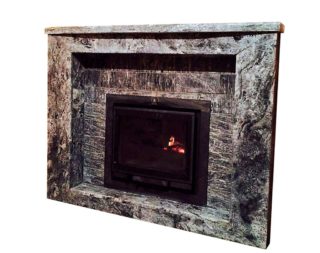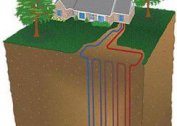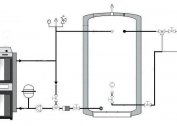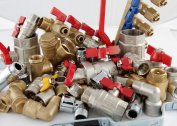Each bath has a furnace for heating the room. The portal for the sauna stove is used for decoration and isolation. This structure favorably emphasizes the beauty of the furnace, closes poorly located structural elements, gives seriousness to the entire structure, and protects nearby wooden elements from fire. Each person who has thought about arranging a bath, personally decides how to approach the arrangement of the framework. It is made of simple or designer materials and can withstand hours of heating from a hot furnace.
Description of the design of the bath furnace
The sauna stove is made of different materials - brick, alloy heat-resistant steel, cast-iron elements. However, the designs are similar. A standard oven includes the following elements:
- Firebox. This is the place of combustion of firewood or other coolant. In brick structures, this place is made of refractory material. In steel - from heat-resistant alloy steel.
- Ashpit. Being placed under the firebox, it is designed to remove precipitating ash and ash. The degree of openness of the ash pan controls the speed of the air supply volume and the rate of combustion of the fuel.
- The combustion chamber is made in the form of a lattice for open passage of the flame, or is closed in metal models.
- Kamenka. Filling with stones, this element of the furnace is the main heat accumulator due to the passage of flame through it or intense heating from the roof of the furnace. Kamenka gives steam in a bath when watering. The higher the temperature of the stones, the lighter the steam.
- A boiler or other hot water tank. It is located directly above the firebox, heater, heated by a pipe passing inside with a flame and smoke. Sometimes boilers are carried outside the furnace by connecting pipes with a special heat exchanger.
- Chimney. This is a natural way to take combustion products out. It is a pipe, sometimes equipped with a draft regulator - a rotary slide damper that prevents heat from escaping after flooding. Even when the damper is completely closed, a gap remains, accounting for 15% of the pipe area, in order to avoid poisoning by combustion products leaking through the cracks.
- Doors This heat-resistant element is necessary for loading fuel. It experiences high temperature loads, so it is made of heat-resistant alloy steel, cast iron or heat-resistant glass.
The stove and portal weigh a lot, so a solid foundation is laid out under the base. On heaving soils, it should not be connected with the base of the house.
Furnaces by design are horizontal, vertical. The shape is barrel-shaped, cylindrical, square.
Types of manufacturing method
The portal for the furnace in the bath is made depending on several parameters:
- room design;
- skills in working with material;
- owner preferences and value.
Mostly used brick or metal. They are easily accessible.
When applying, you do not have to install massive heat-reflecting screens. These materials look beautiful, can be processed at home.
From metal
Metal products are used independently and to create a structure for fastening light materials - wood, drywall and the like. A number of advantages of decorative metal finishes:
- withstands high temperatures;
- fire resistance;
- easy to clean with detergents;
- forged inserts go well with brick and stone.
Interesting look stainless elements of the gate. It is recommended to decorate metal elements with any non-heat-consuming material.
Made of bricks
The brick portal for the sauna stove easily fits into the interior of the sauna room. Fans of the classic style will find the option of red brick. It is heat resistant and tolerates high humidity. In some cases, the use of clinker material is recommended.
The main thing is that the structure of the material is suitable for the interior. More often use a finishing brick with a smooth surface. U-shaped decoration serves for decades inside the bath room, in the relaxation room, on the street.
If the construction of the portal is combined with the installation of a brick screen, the bath unit immediately falls into its regular place. Brick is a universal material for installation.
Materials for the design of the portal
Materials adjacent to the furnace must be non-combustible. For the furnace portal, non-combustible materials are selected in the bathhouse, or the combustibles are separated by heat-reflecting screens. The following apply:
- brick;
- metal;
- a rock;
- glass;
- tile;
- wood;
- drywall.
In addition to brick and metal, gates using masonry made of natural or artificial stone are also popular. Decorative stone makes a simple stove look like an exquisite fireplace. Several types of hard stone are used:
- elements away from the door can be laid out from sedimentary materials - slate, marble, shell rock or foam blocks;
- the pebble facing options recessed into the solution look great.
Stone products are heavy - increase the load on the walls and supports, so the foundation must be massive.
When decorating wooden baths, wood portals are used, made of moisture-proof plywood, parquet board, chipboard. The tree is decorated with carvings and ornaments. Wood materials are mounted on a metal base, which gives additional structural rigidity. Over time, the tree darkens and warps. To avoid this, solid material or well-dried raw materials are used. Sometimes mount inserts made of brick, stone, concrete, use heat-reflecting screens.
The use of glued wood will reduce deformation. Darkening of the material is prevented by varnish in 2-3 layers.
Wooden boards, plywood and drywall are fixed to the frame with self-tapping screws. The frame is made of metal or battens. Self-tapping screws are masked. It is easy to assemble a figured portal from these materials.
The use of ceramic tiles depends on the vision and taste of the owner. The main advantage is easy surface cleaning, resistance to soot pollution.
Wall decoration in the bath for safety
When burning, the surface temperature of the furnace reaches 400 degrees or more. For safe operation, all flammable elements are carried away. 20-25 cm is not enough. Wooden surfaces will light up when exposed to infrared radiation from a preheated oven. This is relevant in the steam room, where temperatures above 100 degrees constantly dry the wood.
The heat-insulating screen is made of brick or basalt cardboard coated with galvanization. In some cases, the talchochloride becomes an insulating material. It conducts heat well, so non-combustible materials make it the basis for it.
The rules of the furnace of the bath
The tactics of heating a bath are constantly being improved taking into account the experience of generations. Rules for the preparation and heating of the room:
- the house is put in order, floors are washed, leaves left over from brooms are swept out;
- garbage is carefully swept in the immediate vicinity of the furnace;
- before the furnace is flooded, the room is ventilated for about 30 minutes;
- with the help of the scoop, the ash chamber and grate are released;
- the oven is inspected for damage;
- the open heater is rinsed;
- tanks are filled with water;
- traction is checked;
- with the help of kindling from natural materials the furnace is melted;
- firewood tosses as it burns.
The heated heater is characterized by instant evaporation of the splashed water. At the first water supply, a layer of ash flies, so it is better to turn away. Having finished heating the bath, they close the windows, ventilation, pour a ladle of warm water on the stove and prepare for bath procedures.
Fire safety standards
Walls from the lining require careful protection when near the heating zone. Safe are the distances from the furnaces:
- brick - not less than 32 cm;
- metal - not less than 1 m;
- lined with iron - 0.7 m.
Such distances are possible only in large doubles. In private baths, compliance with these parameters is an unjustified luxury. Paired in places adjacent to the furnace are finished with protective shields or special materials.
The smallest fire distance, according to SNiP, from the furnace to the combustible wall material is 0.38 m. The height of the non-combustible screen should not be lower than the upper edge of the furnace.
However, it is better to add a dozen centimeters and not regret the omission. The distance on the sides of the remote fuel channel is increased to 0.5 m. Up extend at least the entire height of the wall.
Combustible and brick walls are not connected to each other, leaving a gap of 2-3 cm, which is filled with non-combustible material - heat-resistant mineral wool or basalt cardboard. The joints between the walls are masked by decorative panels.
For decorative finishes, heat-resistant drywall is also used. Processing with fire-resistant compounds increases the duration of resistance to an open flame up to 20-30 minutes. Therefore, when using it is also important to observe fire breaks.
In the manufacture of the portal it is impossible to stack bricks right next to the furnace. A thermal gap of 2.5-3 cm is required. The gap is filled with non-combustible basalt or stone wool. The use of binders is prohibited - even at a temperature of 600 degrees, they are destroyed and spilled out. It is dangerous to use glass wool - it can withstand temperatures up to 350 degrees, and then it melts.
Using a protective screen with a reflective surface will reduce the heating of the walls of the sauna. Part of the infrared radiation will be reflected back to the steam room. The metal screen is installed with a gap of 2-3 cm to the floor for ventilation. It is forbidden to install a brick screen close to the furnace - air exchange is disturbed, and the masonry becomes unusable.
In some cases, it’s easier to buy a finished version of the portal than to do it yourself. Whatever material for the manufacture of the portal is chosen, it must be fireproof. The portal of the furnace in a brick bath is the most versatile.










